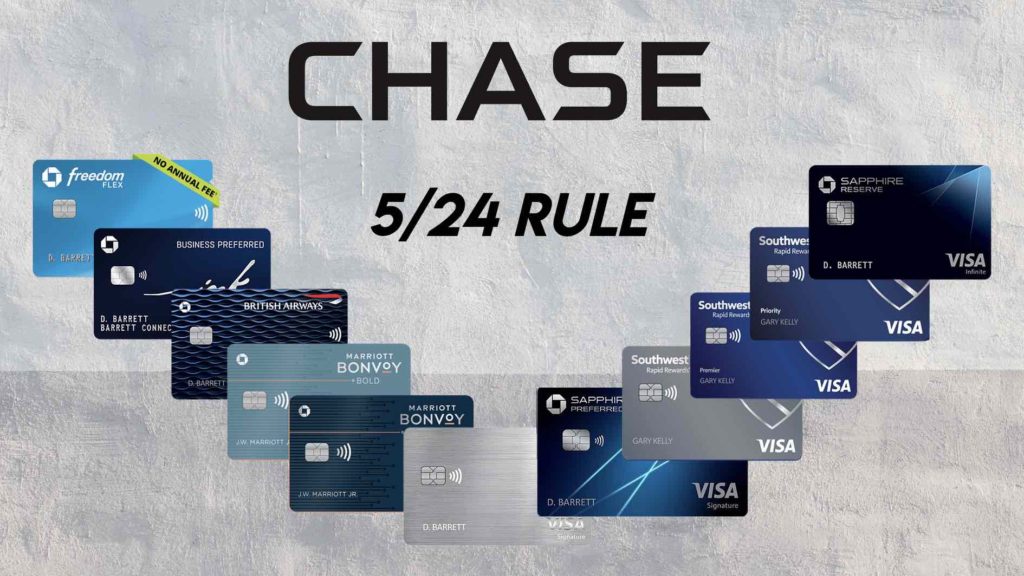by Daniel | Last Updated December 11th, 2021

We may earn a commission for purchases using our links, at no cost to you.
In 2016 Chase initially published the 5/24 rule on its application page for the Chase Sapphire Reserve Card, but not long after they removed all information related to the 5/24 rule.
In this article, I’m going to go into detail about what exactly the Chase 5/24 Rule is, how to check the number of credit cards you have applied for, and what you can do to avoid being denied a new credit card.
What Is The Chase 5/24 Rule?
Simply put, the Chase 5/24 rule basically limits the number of credit cards that you can be approved for within a 2 year (24 months) period, and still qualify for another Chase Credit card.
If you want to be approved for a Chase credit card, you must not have been approved for more than 5 credits within the last 24 month period, Hence the name 5/24.
And Chase will look at all credit card issuers when deciding if you meet the requirements for the 5/24 rule.
So if you have been approved for 4 or fewer credit cards over the previous 24 months, you should be ok if you are applying for an additional Chase Credit card, and just remember that you must check your closed accounts as well.
What Chase Cards are Affected by the 5/24 Rule?
Chase will look at all of their credit cards when they are considering an application for any of their cards.
Here is a list of most of them.
- Chase Sapphire Reserve
- Chase Sapphire Preferred Card
- Chase Freedom Flex
- Chase Freedom Unlimited
- Ink Business Cash Credit Card
- Ink Business Preferred Credit Card
- Starbucks Rewards Visa Card
- Amazon Prime Rewards Visa Signature Card
- Disney Premier Visa Card
- Disney Visa Card
- World of Hyatt Credit Card
- IHG Rewards Club Premier Credit Card
- IHG Rewards Club Traveler Credit Card
- Marriott Bonvoy Boundless Credit Card
- Marriott Bonvoy Bold Credit Card
- Southwest Rapid Rewards Plus Credit Card
- Southwest Rapid Rewards Premier Credit Card
- Southwest Rapid Rewards Priority Credit Card
- Southwest Rapid Rewards Premier Business Credit Card
- Southwest Rapid Rewards Performance Business Credit Card
- United Gateway Card
- United Explorer Card
- United Quest Card
- United Club Infinite Card
- United Business Card
- British Airways Visa Signature Card
- Aer Lingus Visa Signature Card
- Iberia Visa Signature Card
Now it’s worth noting that any business cards that are not listed on your personal credit report will not add to the 5/24 status.
Also, any credit cards that were opened more than 24 months ago will not affect your application.
How To Check Your 5/24 Status
One of the easiest ways to check your 5/24 status is by getting a free copy of your full credit report from the website annualcreditreport.com, and just a note, you are allowed one free report every 12 months from either Experian, TransUnion, or Equifax.
Now once you have your credit report, it will provide all the information you need regarding how many credit cards you have opened or closed during the time period you chose, Which should be 24 months in this case.
And to put it simply, you just need to make sure you have not been approved for more than 5 credit cards over the past two years if you want to apply for another credit card with Chase.
So if you have been approved for just 4 credit cards over the past 24 months, you should be fine to apply for a new card with Chase.
Another thing to know is that even if you close a credit card at any point, Chase will still count it towards their 5/24 rule, assuming it is within the past 24 months.
Whats The Point Of The 5/24 Rule?
Basically, it comes down to profit.
People who churn credit cards can end up costing credit card companies millions of dollars, as they earn a large portion of their profit by charging consumers and merchants fees for accepting cards, and by charging consumers interest on any carried over balance.
To put the amount of rewards paid back to customers into perspective, in 2016 credit card companies paid out approximately $22 billion dollars in rewards to customers.
So to put it simply, if you don’t use the cards, they lose money.
Whats The Best Strategy Going Forward?
So now that you know that it’s not really possible to apply for every single credit card available, what’s the best strategy to keep earning welcome offers?
If you plan and time what credit cards you want to apply for each year, you should be able to stay clear of the 5/24 rule.
But make sure to check out the rules of each credit card issuer as some Chase cards will only allow you to receive a welcome bonus once in a 48 month period.
And American Express also limits how many welcome bonuses customers can earn depending on other factors.
Also, if you are looking at applying for a more expensive credit card that has a relatively high spend requirement to earn the sign-up bonus, it might be worth waiting apply until you know you have some large purchases or bills to pay such as buying a car or paying for school fees.
